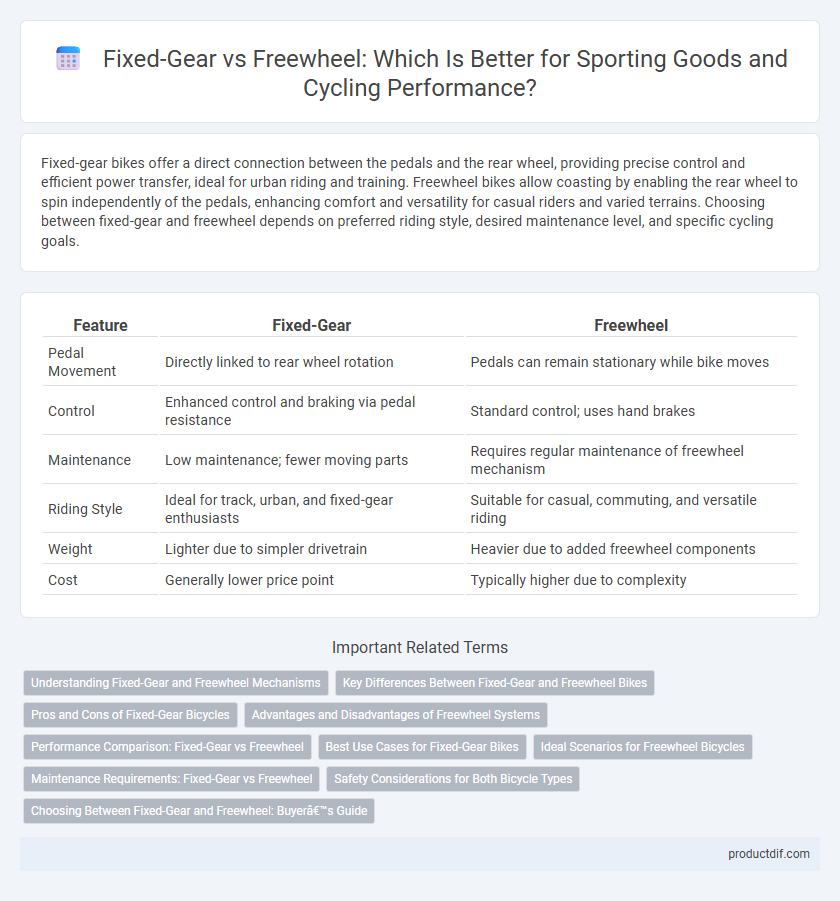Fixed-gear bikes offer a direct connection between the pedals and the rear wheel, providing precise control and efficient power transfer, ideal for urban riding and training. Freewheel bikes allow coasting by enabling the rear wheel to spin independently of the pedals, enhancing comfort and versatility for casual riders and varied terrains. Choosing between fixed-gear and freewheel depends on preferred riding style, desired maintenance level, and specific cycling goals.
Table of Comparison
| Feature | Fixed-Gear | Freewheel |
|---|---|---|
| Pedal Movement | Directly linked to rear wheel rotation | Pedals can remain stationary while bike moves |
| Control | Enhanced control and braking via pedal resistance | Standard control; uses hand brakes |
| Maintenance | Low maintenance; fewer moving parts | Requires regular maintenance of freewheel mechanism |
| Riding Style | Ideal for track, urban, and fixed-gear enthusiasts | Suitable for casual, commuting, and versatile riding |
| Weight | Lighter due to simpler drivetrain | Heavier due to added freewheel components |
| Cost | Generally lower price point | Typically higher due to complexity |
Understanding Fixed-Gear and Freewheel Mechanisms
Fixed-gear bicycles use a drivetrain where the rear cog is directly connected to the motion of the pedals, ensuring the pedals move whenever the bike is in motion, offering greater control and a more engaging riding experience. Freewheel mechanisms incorporate a ratchet system allowing the rear wheel to spin independently of the pedals, enabling coasting and reducing leg fatigue during rides. Understanding these differences is crucial for selecting a bike suited to specific riding styles and terrain, optimizing performance and comfort.
Key Differences Between Fixed-Gear and Freewheel Bikes
Fixed-gear bikes feature a drivetrain directly connected to the rear wheel, meaning the pedals move whenever the bike is in motion, offering greater control and a more efficient power transfer ideal for track cycling and urban commuting. Freewheel bikes allow the rear wheel to spin independently of the pedals, enabling coasting and providing easier handling on varied terrain, making them popular for casual riding and long-distance cycling. The key differences lie in pedal motion dynamics, braking methods, and bike maintenance, with fixed-gear bikes requiring constant pedaling and typically using leg braking, while freewheel bikes support coasting and conventional hand brakes.
Pros and Cons of Fixed-Gear Bicycles
Fixed-gear bicycles offer enhanced control and a direct riding experience by connecting pedals directly to the wheel, improving power transfer and bike handling. They require less maintenance due to their simpler drivetrain with fewer components prone to wear, making them lighter and more reliable for urban commuting. However, fixed-gear bikes lack the ability to coast, which can cause leg fatigue on long rides and present challenges when navigating steep hills or heavy traffic.
Advantages and Disadvantages of Freewheel Systems
Freewheel systems in sporting goods, particularly bicycles, offer advantages such as easier coasting and simplified maintenance due to their integrated ratchet mechanism. However, disadvantages include reduced efficiency in power transfer compared to fixed-gear systems and potential wear on the freewheel bearings over time. Riders seeking flexibility and comfort often prefer freewheel setups despite these trade-offs.
Performance Comparison: Fixed-Gear vs Freewheel
Fixed-gear bikes offer superior control and efficiency by maintaining constant pedal engagement, enhancing power transfer and responsiveness during acceleration. Freewheel systems provide greater versatility and ease of use, allowing coasting and reduced strain on joints, which benefits endurance and casual riding. Performance-wise, fixed-gear setups excel in track racing and urban sprinting, while freewheel options dominate long-distance comfort and varied terrain adaptability.
Best Use Cases for Fixed-Gear Bikes
Fixed-gear bikes excel in urban commuting and track cycling due to their simplicity and direct power transfer, making them ideal for riders seeking minimal maintenance and improved pedal control. Their fixed drivetrain allows for enhanced braking techniques and precise cadence regulation, favored in fixed-gear racing and skill development. Riders who thrive on a lightweight, responsive bike benefit the most from fixed-gear setups in city environments and velodrome conditions.
Ideal Scenarios for Freewheel Bicycles
Freewheel bicycles excel in urban commuting and casual riding where ease of use and low maintenance are priorities. Ideal scenarios include flat terrains, city streets, and mixed-use paths where frequent stops and starts occur, allowing riders to benefit from coasting without pedaling. The freewheel mechanism enhances comfort and control during stop-and-go traffic environments, making it a popular choice for recreational cyclists and daily commuters.
Maintenance Requirements: Fixed-Gear vs Freewheel
Fixed-gear bikes require more frequent chain lubrication and tension adjustments due to the constant drivetrain engagement, which increases wear on components. Freewheel bikes benefit from a more relaxed maintenance schedule since the freewheel mechanism allows coasting, reducing stress on the drivetrain and extending the lifespan of parts like the chain and sprockets. Regular inspection of bearings and brake systems remains essential for both types to ensure optimal performance and safety.
Safety Considerations for Both Bicycle Types
Fixed-gear bicycles offer direct pedal control, which enhances rider stability but requires constant pedaling, increasing the risk of skidding on slippery surfaces. Freewheel bikes allow coasting, reducing leg fatigue and enabling quicker stops, yet they may pose a higher risk during sudden deceleration due to delayed pedal response. Safety gear like helmets and proper braking systems are crucial for both types to mitigate injury risks in varying urban and off-road conditions.
Choosing Between Fixed-Gear and Freewheel: Buyer’s Guide
Choosing between fixed-gear and freewheel bicycles depends on riding style, terrain, and maintenance preferences. Fixed-gear bikes offer a direct drive with no coasting, providing better control and efficiency for urban commuting and track cycling. Freewheel bikes allow coasting and easier hill climbing, making them versatile for varied terrains and casual riders seeking comfort and easier maintenance.
Fixed-Gear vs Freewheel Infographic

 productdif.com
productdif.com